Paw Patrol: tracking down the Ethiopian wolf
We climb one of Ethiopia’s tallest mountains, Mount Abuna Yosef, for a glimpse of the world’s rarest wild canine
Milky dawn light sweeps over the high, cold moorlands. The silence is absolute, until – from out of the shadows – comes a flash of movement. With unnerving speed and silence, a large creature races across the terrain. Suddenly, as if picking up a scent, it freezes and turns its head towards me. For a few seconds its unblinking eyes lock onto mine. My heart thumps with excitement, respect, awe. But then, the creature abruptly turns and continues its soundless journey. My encounter with an Ethiopian wolf is over as suddenly as it began.
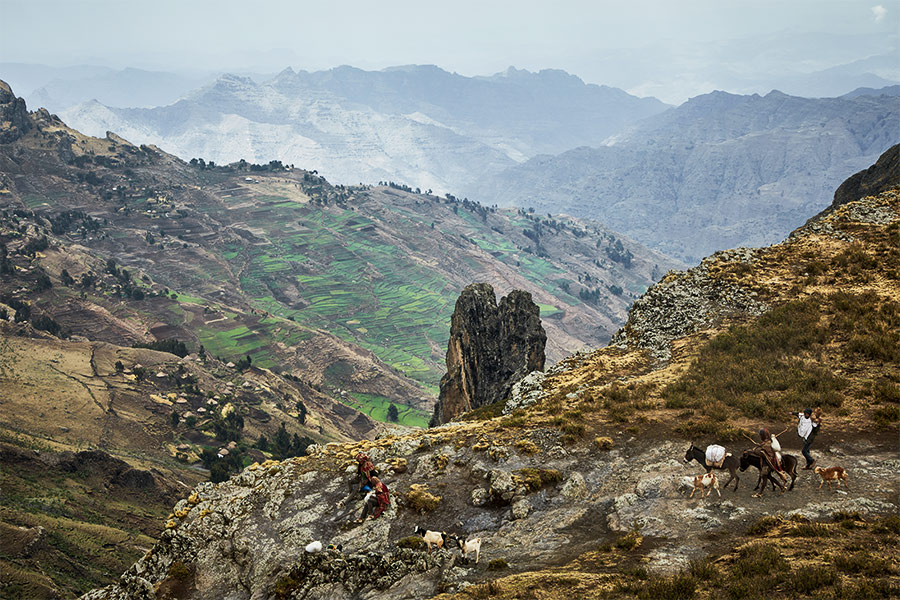
Villagers searching for wolves / Image: Stuart Butler

This is not the big bad wolf of European fairy tales. With a slender and delicate frame, long legs and a cropped, rusty coat, it looks more like a fox or jackal. Sometimes called the Simien fox, it poses no threat to people at all.
Peering out from a dark blue, woolly hat, Dessiew Gelaw lowers his binoculars and smiles. “We were lucky,” he says. “In recent months the wolves that live here have been harder to see. A couple of years ago I used to see groups of five or six almost every day. Now I might see only one or two.”
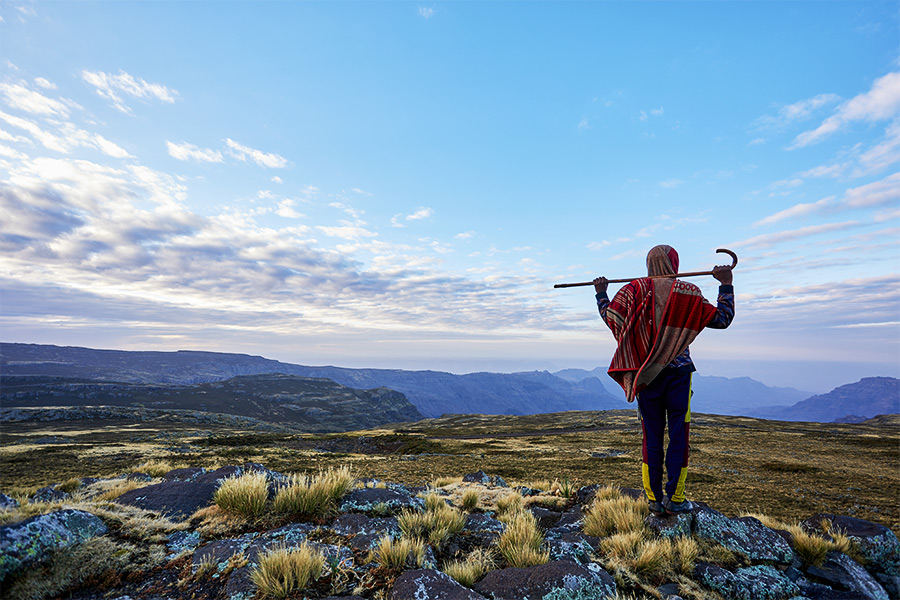
Wolf watching from way up high / Image: Stuart Butler

With fewer than 500 of them remaining, the Ethiopian wolf has the unfortunate distinction of being the rarest species of wild canine in the world. Gelaw is a wolf monitor from the Ethiopian Wolf Conservation Programme, an NGO charged with protecting the Ethiopian wolf population and its habitats. It works to track and study wolf populations, control potential disease outbreaks and, when necessary, translocate wolves to boost other populations.
The programme also works with communities in areas where wolves live, to increase awareness of their plight, dispel myths about them attacking livestock and educate on how people and wolves can live together in harmony.
“These wolves only live in certain parts of the Ethiopian mountains and nowhere else on Earth, so this habitat is critically important to them”
Leaving the wolf to search out a giant mole rat for breakfast, Gelaw suggests that we climb to the summit of Mount Abuna Yosef, a 4,260m-high, thumbnail-shaped peak looming above. It’s just a half-hour scramble over scree to reach the summit, but from its lofty top a superb view unfolds. To the north, a great abyss opens out with vertical cliffs dropping hundreds of metres down toward the valley floor. In all other directions, the giant lobelia-clad mountain slopes downward to a vast blanket of moorland, where we’ve spent the past couple of days tracking Abuna Yosef’s modest wolf population. Until this morning, we’d had no luck.
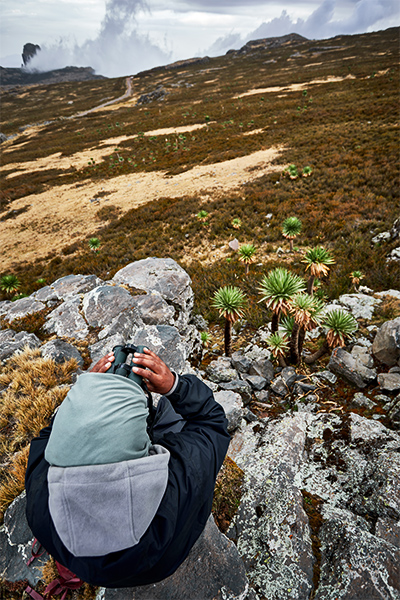
Scanning the moorlands / Image: Stuart Butler
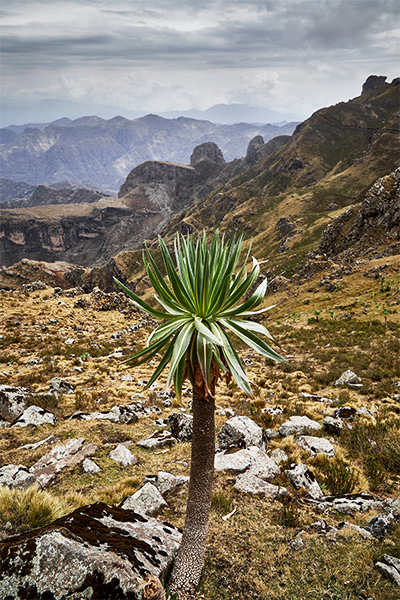
Out in the wilderness / Image: Stuart Butler
As we cautiously balance ourselves on a rocky summit knoll, I ask Gelaw if his lack of recent wolf sightings means that the endangered population of wolves around Abuna Yosef is declining further. “Though small, the population is stable, but the wolves all seem to have gone down lower into the valleys,” he says, waving his hand at the nearby chasm. “It might be because they have gone down to the farmland to feed on rodents attracted to the crops.” Human encroachment into wolf territory seems to be changing the canines’ habits, and causing new challenges for those who track them for a living.
As a bank of cloud rises out of the valley and swallows the peak, we descend back down the mountain. Gelaw tells me how there are three distinct packs of wolves in the Abuna Yosef region, with a total population of around 30 wolves. “These wolves only live in certain parts of the Ethiopian mountains and nowhere else on Earth, so this habitat is critically important to them,” he says.
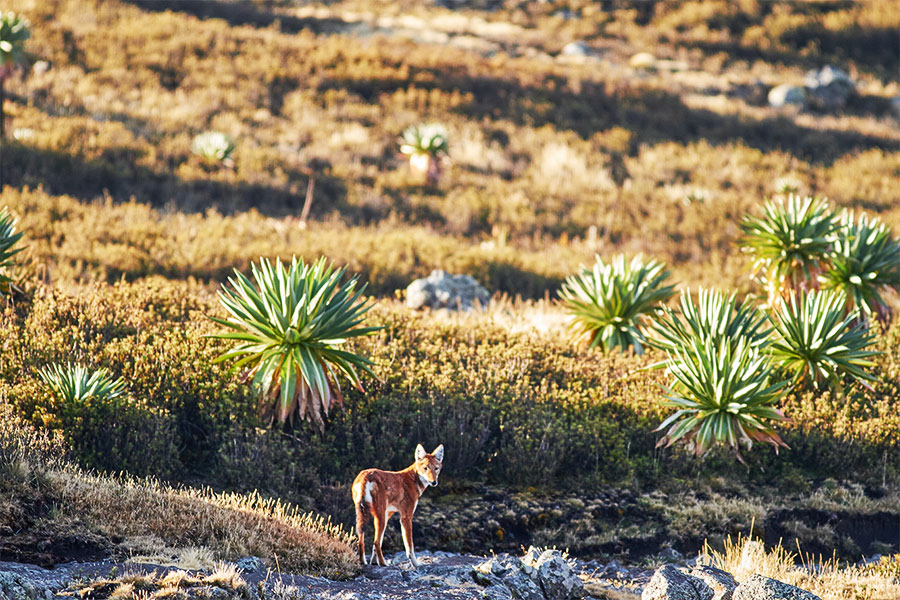
Busted: the Ethiopian wolf watches the watchers / Image: Stuart Butler

In addition to the Abuna Yosef population, there are other wolf hotspots in Ethiopia. In the Menz-Guassa Community Conservation Area, to the northeast of Addis Ababa, between 25 and 30 wolves eke out an existence. And in the southern Bale Mountains, there’s a healthier population of some 200-300 wolves.
“When I learned how rare the wolves are, my attitude to them changed. Now, every time I see a wolf, it excites me. The wolf is my life”
Having left the wolves in Abuna Yosef, I travel to the rock-hewn temples of Lalibela, the nearest town to the mountain, and hop on a plane back to Addis Ababa. The silence and wildlife of the moorlands feel a million miles away. I arrange to meet Eric Bedin, a field director from the Ethiopian Wolf Conservation Programme. Bedin hails from the French Pyrenees mountains but has spent many years studying wolves in Ethiopia. He’s one of the world’s leading authorities on these canines.
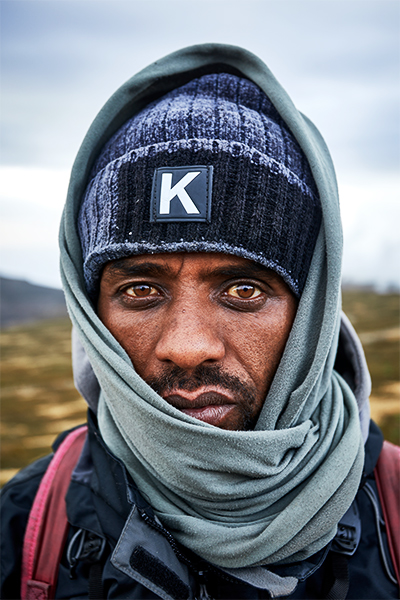
Dessiew Gelaw / Image: Stuart Butler

Gelaw keeping a track on wolf numbers / Image: Stuart Butler
“There are two main threats to Ethiopia’s wolves,” he explains over a small cup of thick, aromatic coffee. “The first are diseases such as rabies and canine distemper, which can be transmitted to wolves from domestic dogs. We have a limited rabies vaccination programme, which helps, but we can’t vaccinate all the wolves or dogs.
“The other, bigger threat is habitat loss. Ethiopia’s human population is growing fast [the current annual growth rate stands at 2.6%] and all these extra people need somewhere to live and food to eat. Inevitably, this means more encroachment into wolf country and the areas around it.
“The wolf populations here are now living on moorland islands surrounded by people and agricultural land. Although most of the current wolf habitat is now under some form of official or community protection, the overall wolf population in Ethiopia has continued to slowly drop.”
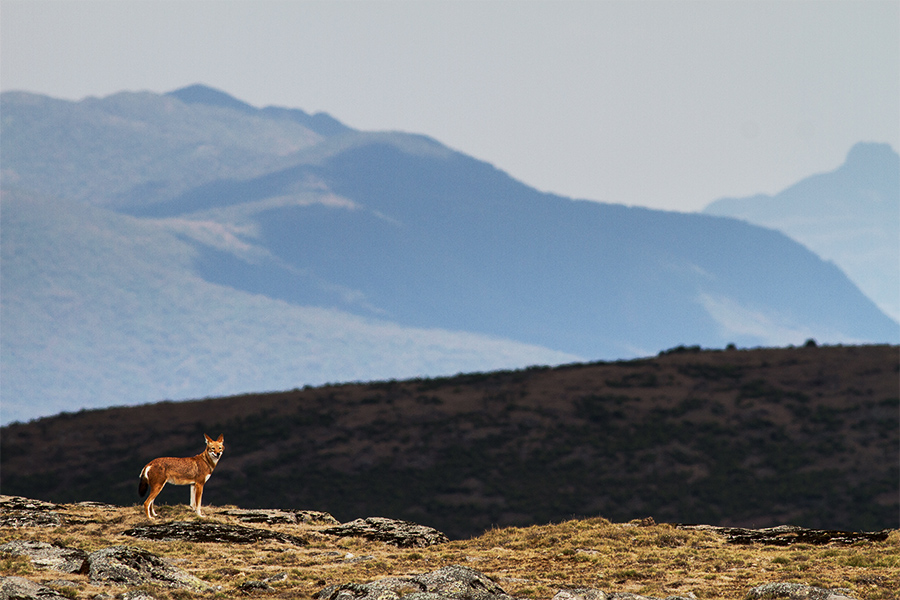
Born to be wild: the Ethiopian wolf on its home turf / Image: Stuart Butler

The work of the Ethiopian Wolf Conservation Programme aims to reverse the trend, and has some luck on its side. Unlike in many parts of the world where predators – real or perceived – can be hounded down by humans, in Ethiopia this is less common. “Wolves are sometimes blamed for attacking lambs and farmers, and shepherds will chase wolves away,” says Bedin. “But people rarely go out of their way to harm a wolf.”
His words echo something that Gelaw had said, as we’d descended Abuna Yosef. “When I was a child, I hated wolves because they attacked my family’s sheep,” he’d remembered. “But when I learned how rare the wolves are, and that they live only in Ethiopia, my attitude to them changed. Now, every time I see a wolf, it excites me. The wolf is my life.”
Gelaw had paused and looked me in the eye, with all the intensity of that lone wolf I’d come face-to-face with that morning. “For me,” he’d said, “The wolf is Ethiopia.”